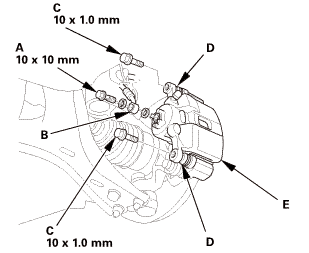Honda Civic Service Manual: Front Brake Caliper Removal and Installation (Natural Gas models)

| 1. | Vehicle Lift |
|
| 2. | Front Wheel |
|
|
|
| 3. | Front Brake Caliper Body (Natural Gas Model) |
|
|
Do not spill brake fluid on the vehicle; it may damage the paint. If brake fluid does contact the paint, wash it off immediately with water.
|
||||||||||||
| 4. | Front Brake Pad (Natural Gas Model) |
|
|
|
|
|
|
| 5. | Front Brake Caliper Pin and Boot (Natural Gas Model) |
|
|
|
|||||||||

| 1. | Front Brake Caliper Pin and Boot (Natural Gas Model) |
|
|
|
|||||||||||||||||||||||||||
| 2. | Front Brake Pad (Natural Gas Model) |
|
|
|
||||||||||||
|
|
|
| 3. | Front Brake Caliper Body (Natural Gas Model) |
|
|
|
| 4. | Brake System - Bleeding (Natural Gas Model) |
|
|
Do not spill brake fluid on the vehicle; it may damage the paint. If brake fluid does contact the paint, wash it off immediately with water.
|
|
|
|
||||||
|
Front
Rear
|
|
| 5. | Front Wheel |
|
|
|
||||||
 Brake Calipers
Brake Calipers
...
 Rear Brake Caliper Overhaul
Rear Brake Caliper Overhaul
View
1.
Rear Brake Caliper Exploded View
Exploded View
Disassembly
Frequent inhalation of brake pad dust, regardless of material composition, co ...
See also:
Honda Civic Owners Manual. Adjusting the Shoulder Anchor
The front seats have adjustable shoulder anchors to accommodate taller and
shorter
occupants.
1. Move the anchor up and down while
pulling the release outward.
2. Position the anchor so that the belt rests
across the center of your chest and over
your shoulder.
Adjusting the Shoulder ...











 (5.1mn)lummm,nu-nu
(5.1mn)lummm,nu-nu
 sznuzucz
sznuzucz x.sm.x1imm
x.sm.x1imm
 mmmln-mnomm
mmmln-mnomm